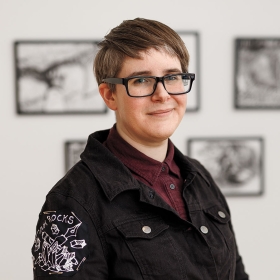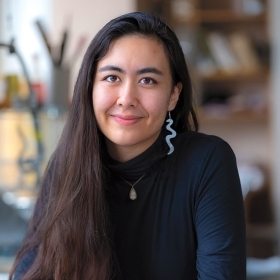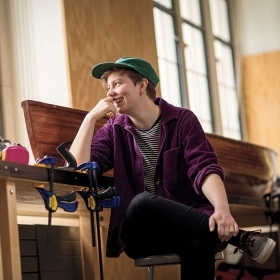Samara Pearlstein touches a “little bit of almost every part” of the Wellesley College Art Department. She is the program coordinator for the department, the building manager for the Jewett Arts Center and Pendleton West, and a drawing instructor for the studio program in the summer. She is also the gallery director for Jewett Art Gallery.

Samara Pearlstein touches a “little bit of almost every part” of the Wellesley College Art Department, which she joined eight years ago. She is the program coordinator for the department, the building manager for the Jewett Arts Center and Pendleton West, and a drawing instructor for the studio program in the summer. She is also the gallery director for Jewett Art Gallery and its satellite spaces. At the time of this interview, Pearlstein’s own art was on display in the department staff show Time and a Half. She spoke with Wellesley about her perspective on the gallery and the department overall.
“A lot of other schools—and other departments at Wellesley—don’t have that really close connection between the making and the thinking, but in the art department, we’re really doing the heck out of both.”
Wellesley: What is special about the arts at Wellesley?
Pearlstein: There is something about the way art history and studio art play together here that I think benefits both. At Wellesley, you have this incredibly strong theoretical backing and art historical context that elevates the way people approach studio art, and vice versa. … A lot of other schools—and other departments at Wellesley—don’t have that really close connection between the making and the thinking, but in the art department, we’re really doing the heck out of both. Both are operating at the same very high level.
How does it feel to have your own drawings in the gallery where you spend much of your time?
It’s been weird and fun and delightful. Installing it, because it’s my own work, I was like, “Whatever, I don’t care, we’ll do whatever with it. I’m gonna frame it the worst way anything has ever been framed and just put it up.” But it’s actually been pretty amazing having conversations with people. It has helped me clarify what I’m doing. I kind of suspected that was going to happen, but I don’t think I realized the amount that it would happen. … Some of the best conversations I’ve had about it have been with students. I always say this in the classroom: I become a better drawer by teaching people drawing. And talking to people about that work has made me understand the work better, which has been a delight.
What unusual requests have you received for gallery installations?
There have been a lot of material requests … like, “Can I leave food to rot in here for a month?” “Can I make a piece with blood all over the place, just in open air?” We’re just not that kind of institution—we’re not really set up to do that safely. Sometimes we get to say yes, like for the student [Charlie Galloway ’17] who put a boat in the gallery. … That was a very weird ask that we were able to say yes to, and it was lovely and amazing.

